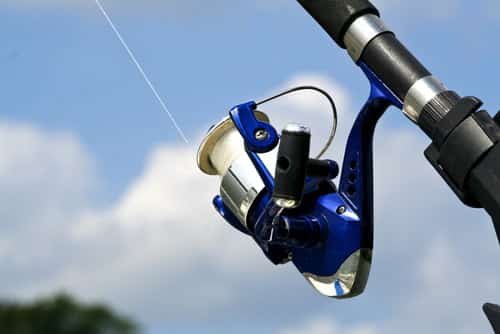Freshwater Fishing Reel: The Best Reel for 2023!
Before diving headfirst into the world of freshwater fishing, you must equip yourself with the right tools for success. And that’s where fishing reels come into play. This blog will help you identify the best freshwater fishing reel in 2023.
Fishing reels are vital components of any angler’s arsenal. They are mechanical devices mounted on fishing rods that allow you to smoothly deploy and retrieve your fishing line. Several types of freshwater fishing reels are available on the market today, each with unique features and functionalities. Let’s start with spinning reels, also known as open-faced reels.
Open-faced reels

These versatile reels are widely popular among anglers due to their ease of use and versatility. With a spinning reel, the spool stays stationary during casting while allowing the line to flow smoothly off it. This design makes them perfect for beginners or those who prefer finesse techniques like light tackle fishing in freshwater lakes or rivers.
Baitcasting reels

Next up are baitcasting reels – often called level-wind or overhead reels – that offer excellent control and precision when casting heavier lures or baits. Baitcasting reels utilize a revolving spool that rotates as you cast, allowing for longer and more accurate casts than spinning reels. They excel in heavy cover situations where accuracy is crucial for placing your lure precisely where fish lurk beneath obstacles like fallen trees or dense vegetation.
Fly reels

If you’re looking for something more specialized, fly fishing enthusiasts swear by fly reels designed specifically for their unique technique. Unlike other types of reel systems discussed earlier that hold monofilament or braided lines, fly reels accommodate fly lines – specialized weight-forward or double taper lines used in fly fishing.
These reels are designed to smoothly retrieve or let out the fly line as you cast and play fish, offering a delicate presentation for targeting species like trout or salmon.
Spin cast reels

Last but not least, we have spin cast reels, commonly known as closed-face reels. These reels cater to beginners and casual anglers who prioritize simplicity and ease of use. The line is enclosed within a cone-shaped cover with a spin cast reel, protecting it from external elements and greatly reducing tangles or backlash during casting.
While not as popular among experienced anglers due to their limited line capacity and less precise casting performance, spin cast reels are great entry-level options for kids or those just starting freshwater fishing.
Now that you have a general overview of the different types of freshwater fishing reels available, it’s important to understand the pros and cons associated with each one. Let’s delve deeper into these aspects.
Pros and Cons – Freshwater Fishing Reel
When it comes to freshwater fishing, choosing the right reel can make a difference in your overall experience. Several fishing reels are available, each with advantages and disadvantages. Let’s dive into the pros and cons of each type so you can make an informed decision.
Spinning reels
First up, we have the spinning reel. This is perhaps the most popular type of reel among freshwater anglers. One of the biggest advantages of a spinning reel is its versatility. It can handle various fishing line weights, making it suitable for various fishing techniques and species.
Additionally, spinning reels are easy to use and offer excellent casting distance. However, one drawback is that they may not be as durable as other reel types. They also tend to have a slower retrieval rate compared to other reels.
Baitcasting reels
Next on our list is the baitcasting reel. This reel type offers great control and accuracy, making it ideal for more experienced anglers who want precise casts and control over their presentation. Baitcasting reels are also known for their higher retrieval rates, allowing you to bring in your catch quickly.
On the downside, bait casters can be challenging to master, especially for beginners who may struggle with backlash or bird’s nests during casting. They typically require more maintenance as well.
Spin cast reels
Another option worth considering is the spin cast reel (closed-face or push-button reels). These reels are often recommended for beginners due to their simplicity and ease of use. Spincast reels feature a covered design that helps prevent tangles and backlash during casting, making them less frustrating for those new to fishing.
However, they have some limitations regarding line capacity and may not be suitable for targeting larger fish species.
Fly reels
Let’s not forget fly fishing reels – an integral part of fly-fishing gear setups. Fly reels are designed to hold fly line weight while providing smooth drag systems for landing fish. One major advantage of fly reels is their ability to handle light line weights, making them perfect for delicate presentations and targeting trout and other small fish species.
However, fly reels do not contribute much to casting distance or retrieval rate, unlike other reel types, since the angler’s hand movements primarily control the line.
Each type of fishing reel has its own set of pros and cons. Consider your skill level, target species, fishing techniques, and personal preferences when deciding which reel to choose.
A spin cast reel might be the way for beginners or those seeking simplicity. Experienced anglers who value precision may opt for a baitcasting reel.
Spinning reels offer versatility and ease of use, while fly reels are essential for fly-fishing enthusiasts. Remember that pairing your chosen reel with a suitable fishing rod is crucial for achieving optimal performance on the water.
Choosing the Best Freshwater Fishing Reel
When choosing the right freshwater fishing reel, there are a few factors to consider that will greatly impact your fishing experience. First and foremost, you need to consider the type of fishing you’ll be doing. Are you planning on casting lures or using live bait?
This will determine whether a spinning reel or a baitcasting reel is more suitable for your needs. Spinning reels are easier to use and great for beginners as they require less skill when it comes to casting accuracy.
On the other hand, baitcasting reels offer more control and power, making them ideal for targeting larger fish species. Next, you’ll want to match your fishing reel with the appropriate fishing rod.
Some anglers prefer purchasing a rod and reel combo as it ensures compatibility between the two components. However, if you already have a rod or prefer buying them separately, make sure the reel is compatible with the rod’s specifications in terms of length, power, and action.
Choosing the Line Weight of Your Freshwater Fishing Reel
Consider the weight of your fishing line as well when selecting a reel. Different reels are designed to handle specific line weights efficiently.
For instance, lightweight spinning reels work best with light lines (4-10 lb test), while heavier saltwater spinning reels can handle heavier lines (12-30 lb test). Baitcasting reels typically handle heavier lines (10-20 lb test) suited for targeting larger fish.
Weigh the pros and cons of each type of fishing reel before making your final decision. Spinning reels offer ease of use and versatility but may lack casting distance compared to bait casters.
Baitcasting reels provide greater control and accuracy but require more practice to master their casting technique. By considering these factors – type of fishing, matching with appropriate rods, and line weight compatibility – you’ll be able to choose a freshwater fishing reel that suits your needs perfectly and enhances your angling adventures on the water!

Conclusion – Best Freshwater Fishing Reel
Choosing the right freshwater fishing reel is crucial for a successful fishing experience. After exploring the different types of reels and weighing their pros and cons, it becomes evident that there is no one-size-fits-all solution. The decision ultimately depends on your preferences, fishing style, and target species.
Whether you opt for a spinning reel with its versatility and ease of use or a baitcasting reel for ultimate control and precision casting, the choice should be based on what feels comfortable in your hands. Consider factors such as the size and weight of the reel, as well as its gear ratio, to match your preferred fishing line weight and target species.
Consider whether you prefer an open or closed-faced design that offers added protection against water intrusion. Additionally, consider whether you want to invest in a high-quality fishing rod and reel combo or purchase them separately to customize your setup.
Remember that practice makes perfect when it comes to using different types of fishing reels. Be patient with yourself as you get accustomed to casting techniques specific to each reel type.





